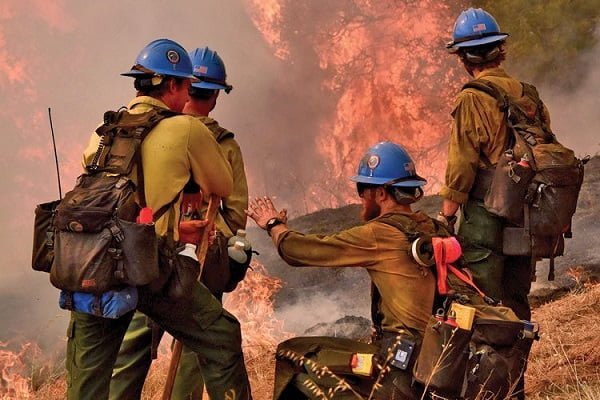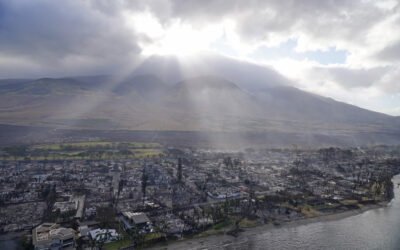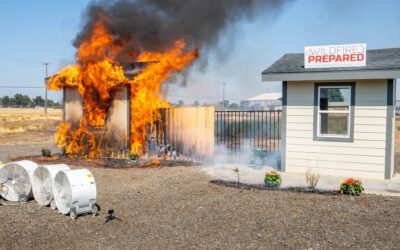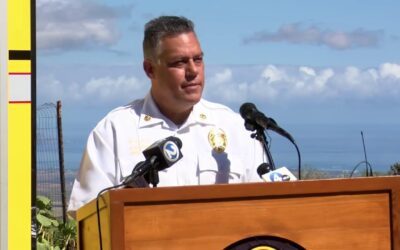A danger in the face of climate change

Climate change, specifically global warming, has contributed to increased incidence of wildfires and the lengthening of wildfire seasons. (Photo by Keith D. Cullom/www.fire-image.com.)
Dean Ali | FireRescue Magazine Volume 12, Issue 8
The projected impacts of climate change-induced global warming are frightening. The thought of milder winters may sound promising to some, but the implications of warmer artic weather are devastating. As glaciers melt, sea levels rise, rain patterns change, and extreme weather patterns bring devastation to communities. The 2016-2017 North Carolina winter was mild, and now residents are experiencing the negative effects: more mosquitos, termites, and pollen.
Climate change, specifically global warming, has contributed to increased incidence of wildfires and the lengthening of wildfire seasons. However, there are other factors that contribute to the loss of life, property, and environmental damage resulting from wildfires. The fire service must focus on wildland fire scene preparation, training, and management. Increasing focus toward wildland fire education and training will assist with limiting the damage caused by wildfires. Many urban fire departments have limited training on wildfires because of the historical separation between urban firefighting and wildland firefighting. In fact, most urban firefighters have no training or experience when it comes to a wildland fire. While the WUI comprises 10 percent of the United States, career wildland firefighters make up only five percent of the total number of career firefighters in the United States.
The aim of this article is to focus on policy recommendations to help prevent the escape of future wildfires and assist suppression forces tasked with protecting life and property by combating wildfires.
Wildfire Prevention and Mitigation
The aforementioned initiatives to combat climate change are promising, yet the rewards of their effort could take decades to appreciate. Unfortunately, recent extreme wildfires have demonstrated the need for immediate intervention to save lives and property. Because the WUI has grown and is expected to continue to grow, fire prevention in this area through education is critical.1 As mentioned earlier, human ignition is associated with 90 percent of wildfires.
Prevention must consist of a systematic approach in terms of development, education outreach, grants, and community resources. The community and its homeowners must be engaged because they have a direct interest in prevention. In addition to public education on preventive measures, research conducted after the Waldo Canyon Fire in Colorado discovered the biggest impact on survivability of structures in the WUI is simply a 30-foot clear cut around the home. Eliminating fuel in the form of shrubbery around homes can buy homeowners and firefighters more time in a wildfire event because it simply slows the spread of fire.
United States wildfire policy historically focused entirely on fire suppression; however, because of the recent increase in wildfire severity, this is shifting. The Journal of Forestry evaluated policy changes at the national level that focused on reducing hazardous fuels, ecosystem restoration, and community assistance in the form of prevention. Mitigating long-term risk of wildfire will remain incomplete until a multifaceted approach including prevention and mitigation is used.
Traditionally, wildfires occurring in remote wilderness areas were managed by allowing the fire to do its natural job of managing the environment and forests. Today, this practice is risky because extreme weather caused by climate change yields the unpredictable nature of wind events. All it takes is one wind event to spread the fire outside of a planned perimeter and cause significantly greater devastation. Extinguishing wildfires must move toward an aggressive approach.
In fact, wind speeds and drought conditions were the cause of the fire that started in the Great Smoky Mountains and traveled six miles to Gatlinburg, Tennessee, taking 14 lives and causing $500 million worth of damage. Likewise, a 180-degree wind shift and gusts up to 60 miles per hour were attributed to the death of 19 Granite Mountain Hotshots on June 30, 2013.2 The Granite Mountain Hotshots were an elite team of wildland firefighters who embarked on a mission the morning of June 30 to protect the small town of Yarnell from an advancing wildfire. However, extreme weather caused the wildfire to trap all 20 members of the team. Tragically, all but one perished that day. (2)
Previously, wildfires were not aggressively extinguished, and they were allowed to run their natural course. However, because 90 percent of wildland fires are caused by humans and often occur in areas where lives and private property are threatened, they must be extinguished as quickly as possible. If climatologists’ reports are correct, extreme weather will cause the United States to see more severe wildfires that will be more difficult to suppress.
Fire Suppression Changes
As mentioned, only five percent of career firefighters are wildland firefighters. Structural firefighters simply do not have proper training or equipment to effectively combat wildfires. Many structural fire departments lack training and experience using the National Incident Management System for expanded operations over large geographical areas that are necessary for wildfire suppression.
In April 2009, South Carolina experienced the worst WUI fire in its history. The fire grew rapidly and ultimately burned 19,130 acres, destroyed 76 homes, damaged 97 additional homes, and resulted in $50 million in damages.3 The Highway 31 fire burned for 28 days and provided a valuable learning experience to the Forestry Commission and all responding agencies. (3) The following is a list of recommendations developed by the South Carolina Forestry Commission as a result of the Highway 31 fire and can be found in the after-action report:
Request an incident management team (IMT) and other additional support as soon as possible.
Interagency training on IMTs is crucial.
Annual training exercises (on wildland firefighting) should be conducted where the potential for large fires exist.
Training should include practicing transition from the initial attack to extended attack.
Recognizing extreme fire behavior and potential for fire growth is crucial to ensure additional resources are requested quickly.
Work with the National Weather Service to identify opportunities to improve communication to help it provide the best possible forecasts to predict unusual weather events.
Request aerial observation flights to provide other perspectives of the incident.
Conduct training exercises to practice and improve interoperability between agencies, using common radio channels that are clearly identified.
Training should be conducted with the Army National Guard because it is often activated to assist fire department personnel.
Science and Firefighting
Scientists are also working with fire departments to discover agents that may work more efficiently than water. Simply stated, water is plentiful, efficient and cheap and will never be replaced as the primary extinguishing agent. But, there are situations in wildland firefighting where water access is limited. Lu et al. (2016) researched a multiadditive long-distance suppressant for wildfires occurring near electrical transmission lines.4 WUI fires result in damage to transmission lines and the failure of power grids. This inhibits firefighting because damaged transmission lines are extremely dangerous.
Lu et al. examined an additive that had better performance in fire suppression and ability to prevent reignition than water. These agents are environmentally friendly; all the ingredients of the multicomponent additives were inorganic chemicals that could be used as fertilizer and demonstrated minimal environmental impact. (4) They also developed a fire-suppression system that featured an elevated mobile platform with long-distance and high-lift features to combat the challenges faced by wildland firefighters working near transmission lines. Results of several experiments with the system found that it was in fact more effective at suppression with reduced reignition compared to pure water. The research also discovered that the platform would be effective with use to other firefighting situations, such as high-rise buildings and fires in remote or water-deficient places. (4)
Researchers at the University of North Carolina at Charlotte are working with the Department of Engineering Technology to investigate the effectiveness of prewetting structures, dead fuels, and landscaping plants in preventing fire spread from wildland fires to structures in the WUI.5 They found that the protection of landscaping plants located around structures is critical; unfortunately, their tests found water and foam were not effective. A prewetting gel agent was effective on landscaping plants, building materials, and the mulch from ignition and fire growth. However, there are a significant number of uncontrollable variables related to plants, and future work is required to understand further ignition properties of firebrands on wetting agents. (5)
Policy Recommendations
As demonstrated by the literature, the WUI is growing because of its affordability, scenery, and popularity. Simultaneously, the land has become more susceptible to wildfire ignition because of climate change-induced global warming that has caused the forestland to become prime for ignition. Compounding the dangers in this region are extreme weather and wind events that are attributed climate change. While historically wildfires have been a natural part of a fire adapted ecosystem, 90 percent of wildfires today are caused by careless human ignition. Wildfires located in hot and dry areas can ignite and spread quickly, while extreme weather events make them difficult to control. Now is the time to act and encourage policymakers to address the aforementioned issues of climate change.
Policies must encompass four main areas to limit future wildfire destruction:
All states should follow New York State’s example and move toward WWS electricity.
Initiatives aimed at educating the general population on prevention are critical.
Wildland firefighting tactics must become more aggressive.
Structural firefighters should be trained on wildland firefighting techniques and be properly outfitted.
New York State has demonstrated that moving away from coal and natural gas energy sources is not only feasible but also economically friendly. All states should follow New York’s model for electricity, transportation, heating/cooling, and industry by developing an energy infrastructure derived from WWS. States following this model would significantly reduce GHG damage to the environment, reduce fuel costs, and create jobs. In doing so, they would create a healthier environment that has the potential to reduce air pollution mortality and the financial costs associated with poor air quality. Setting incremental goals is key to success with this process. It is recommended that states set a 30 percent conversion goal with a 15-year time frame. Policymakers must become educated on the danger of climate change and the benefits of reducing GHG emissions.
Because 90 percent of wildfires are attributed to human ignition and carelessness, it is critical that prevention become a priority. Fire departments should develop outreach programs and learn from agencies that have already implemented successful programs, such as the Colorado Springs Fire Department. Members of the fire department are credible sources of prevention education, and they must make time to educate homeowners living in the WUI about what they can do to prevent ignitions. The National Fire Protective Association has developed a free online resource to help guide departments and communities with training and prevention.
As discussed, wildland fires are becoming more difficult to control and traditional methods of attack are not always effective. In the past, fires could continue along their natural course until naturally extinguished by rain or reached a point of reduced fuel. This is no longer a plausible method of response in the WUI. Extreme weather has resulted in an increase in escaped fires, destruction, and death. Fire departments must recognize that fires occurring near the WUI threaten private property and lives and must be extinguished quickly and aggressively.
To assist wildland firefighters in attack, all firefighters, including urban firefighters, must be trained in wildland firefighting techniques. Proper equipment and properly sized firefighting gear must be available to all firefighters. As discussed earlier, structural firefighting gear is heavy and cumbersome and results in poor heat regulation. Thus, it is not practical for wildland firefighting. Grants are also available, and all fire departments should take advantage of grants that could potentially help outfit their members.
The National Fire Academy (NFA) offers free training to all firefighters nationwide, and all fire departments should take advantage of their WUI curriculum. The NFA has 22 courses that are offered online, on campus, and nationwide. A few examples of the online courses offered by the NFA are WUI Incident Management, a 12-module foundation course on Wildland Firefighting, and Introduction to Wildland Fire Behavior.
Examples of on-campus course topics include fire-adapted communities; developing a community wildfire protection plan; strategies for developing a fire-adapted community course; WUI firefighting for the structural company officer; and WUI planning series: evacuation, land use, and fire codes. The United States Fire Administration has a free WUI training toolkit that includes training, outreach, and prevention material. The 2017 Fire Department Instructors Conference International included classroom sessions on Wildland Firefighting Operations: Managing Crew Safety in the Dangerous WUI Environment; Planning for a Wildland Event: A Technology-Based Community Approach; and First-Due Battalion Chief.
Understanding the Danger
It is critical that all fire departments recognize and understand the imminent danger posed to all communities by wildland fires and their role for assisting in mitigating these dangers. In 2016, several dozen firefighters from Wake County (NC) were deployed to assist with controlling the November wildfires burning in Chimney Rock. These firefighters were not trained or properly outfitted; however, they performed to the best of their abilities. A lesson learned from situations like this and the Highway 31 fire is the importance of preparing all firefighters in wildfire operations through training.
Our planet has entered a state of rapid environmental change that is bringing destruction and death in the form of wildfires and extreme wind events. It is critically important that policymakers focus efforts on mitigating the effects of climate change through developing policies that will limit GHG emission and prevent the spread of wildfires. Fire departments have a responsibility to educate citizens on methods of prevention. Finally, all fire departments have a responsibility to train, educate, and outfit their members to become more successful in wildfire operations.
References
1. Haight, R. G., Cleland, D. T., Hammer, R. B., Radeloff, V. C., & Rupp, S., “Assessing Fire Risk in the Wildland-Urban Interface,” Journal of Forestry, 102(7), 41-47, 2004.
2. Dickman, K., “19: The True Story of the Yarnell Hill Fire,” Outside Online, September 17, 2013, Retrieved February 24, 2017, from www.bing.com/cr?IG=4D82D8B0A373410694B818E40B106BEB&CID=12480C19FB236D2903B7062DFA126C9D&rd=1&h=eF40k0KYXX9VdccIO8U94TyESh7XdUAslnwh_yOXcSM&v=1&r=https%3a%2f%2fwww.outsideonline.com%2f1926426%2f19-true-story-yarnell-hill-fire&p=DevEx,5064.1.
3. Jones, D., “Highway 31 Fire After Action Report” (pp. 1-35, Issue brief). SC: South Carolina Foresty Commission, 2010.
4. Lu, J., Chen, B., Wu, C., Liu, X., Zhou, T., & Tan, Y., “A multi-additive suppressant agent-based low-flow and long-distance firefighting approach for suppressing wildfires near electrical transmission lines,” Journal of Fire Sciences, 34(5), 2016, 398-415.
5. Urbas, J., “Effectiveness of pre-applied wetting agents in prevention of wildland urban interface fires,” Fire and Materials, 37(8), 2012, 563-580.
Dena Ali is a captain with the Raleigh (NC) Fire Department and an intermediate with Wake County EMS. Prior to becoming a firefighter, she served five years as a police officer in North Carolina. Ali has a degree from North Carolina State University. She is a graduate student at UNCP, and her research focuses on firefighter suicide. Ali taught her class on suicide prevention at FDIC International 2017. She is an avid cyclist and founding member of the Carolina Brotherhood. Ali also serves as an advocate for 555fitness.




